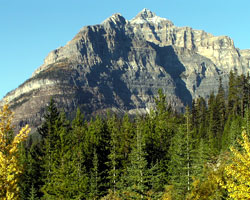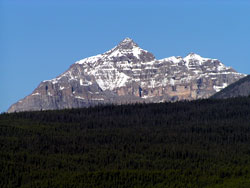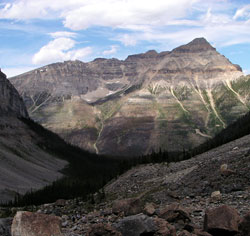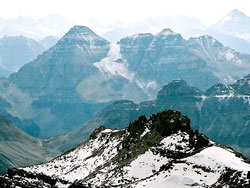
Photo: Mount Whymper from Vermilion Pass
Mount Whymper
- 2845 m (9,334ft)
- First Ascent
- Naming History
Located in the upper Vermilion River Valley between Tokumm River and Chickadee Valley
Province: BC
Park: Kootenay
Headwater: Kootenay
Major Valley: Vermilion
Visible from Highway: 1, 93S
Ascent Party: Edward Whymper
Ascent Guide: J. Bossoney, C. Kaufmann, C. Klucker, J. Pollinger
Named for: Whymper, Edmund (Edmund Whymper was became a well known climber following his first ascent of the Matterhorn in the Alps. In his later years he spent a few seasons in the Rockies.) (see biog.)
The striking peak which lies directly west of Vermilion Pass was named for Edward Whymper. During the summer of 1901, Whymper became the first mountaineer to visit the upper Vermilion Valley. He named Stanley Peak, and also completed, together with the four guides who had travelled from Europe with him, the first ascents of both Stanley Peak and his own mountain. Compared to some of his experiences in the Alps 30 years earlier, Whymper's climb of Mount Whymper must have seemed quite simple and monotonous as a mountaineering challenge. Today the ascent is regarded only as a moderate "scramble," not requiring ropes and certainly not requiring four alpine guides. The mountain was originally named Mount Lefroy and this name appears at the location of today's Mount Whymper on the Palliser Expedition's map that was presented to Parliament in 1863. [McCart] When James Hector crossed Vermilion Pass in 1858 he camped to the west of the pass and wrote in his journal, "I then ascended the mountain to the east (likely Storm Mountain) for 1,000 feet above our camp, reaching the limit of the woods after 500 feet. The mountain...is a mere spur from a large central mass of snow-capped mountains to the south-east, which I named Mount Ball...On the opposite side of the valley I saw that the Vermilion River rises from a glacier of small size in a high valley of Mount Lefroy." [McCart] Hector appears to have been an admirer of General Sir John Henry Lefroy, an astronomer who was particularly interested in studying the magnetic declination from various locations in Canada and who eventually visited the site of the north magnetic pole. It is not clear whether the name of Mount Lefroy 'migrated' to the peak that towers behind Lake Louise or if that mountain was named without any influence from Hector?s naming of what is now Mount Whymper.


